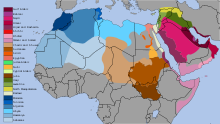Mesopotamian Arabic
| Mesopotamian Arabic | |
|---|---|
| Native to | Iraq, Syria, Iran, Turkey, Cyprus |
| Region | Mesopotamia, Armenian Highlands, Cilicia |
|
Native speakers
|
15 million (2017) |
|
Afro-Asiatic
|
|
| Dialects | |
| Arabic alphabet | |
| Language codes | |
| ISO 639-3 | |
| Glottolog | meso1252 |

Khaki: Iraqi Arabic
|
|
Mesopotamian Arabic is a continuum of mutually-intelligible varieties of Arabic native to the Mesopotamian basin of Iraq as well as spanning into Syria,Iran, southeastern Turkey, and spoken in Iraqi diaspora communities.
Aramaic was the lingua franca in Mesopotamia from the early 1st millennium BCE until the late 1st millennium CE, and as may be expected, Iraqi Arabic shows signs of an Aramaic substrate. The Gelet and the Judeo-Iraqi varieties have retained features of Babylonian Aramaic.
Due to Iraq's inherent multiculturalism as well as history, Iraqi Arabic in turn bears extensive borrowings in its lexicon from Aramaic, Akkadian, Persian and Turkish.
Mesopotamian Arabic has two major varieties. A distinction is recognised between Gelet Mesopotamian Arabic and Qeltu Mesopotamian Arabic, the names deriving from the form of the word for "I said".
The southern (Gelet) group includes a Tigris dialect cluster, of which the best-known form is Baghdadi Arabic, and a Euphrates dialect cluster, known as Furati (Euphrates Arabic). The Gelet variety is also spoken in the Khuzestan Province of Iran.
The northern (Qeltu) group includes the north Tigris dialect cluster, also known as North Mesopotamian Arabic or Maslawi (Mosul Arabic), as well as both Jewish and Christian sectarian dialects (such as Baghdad Jewish Arabic).
...
Wikipedia
